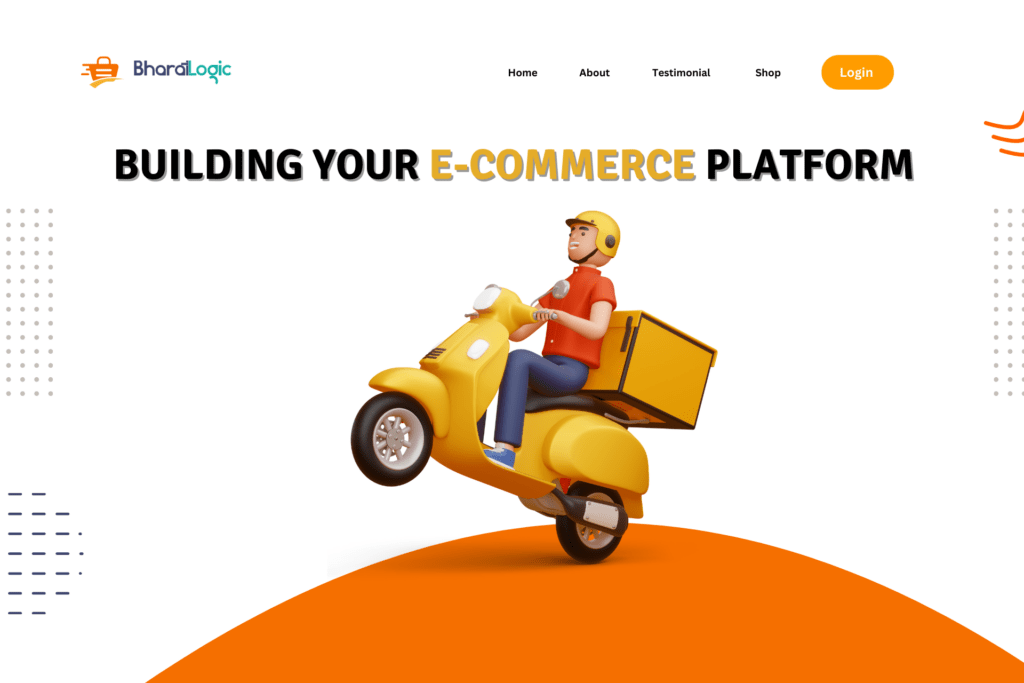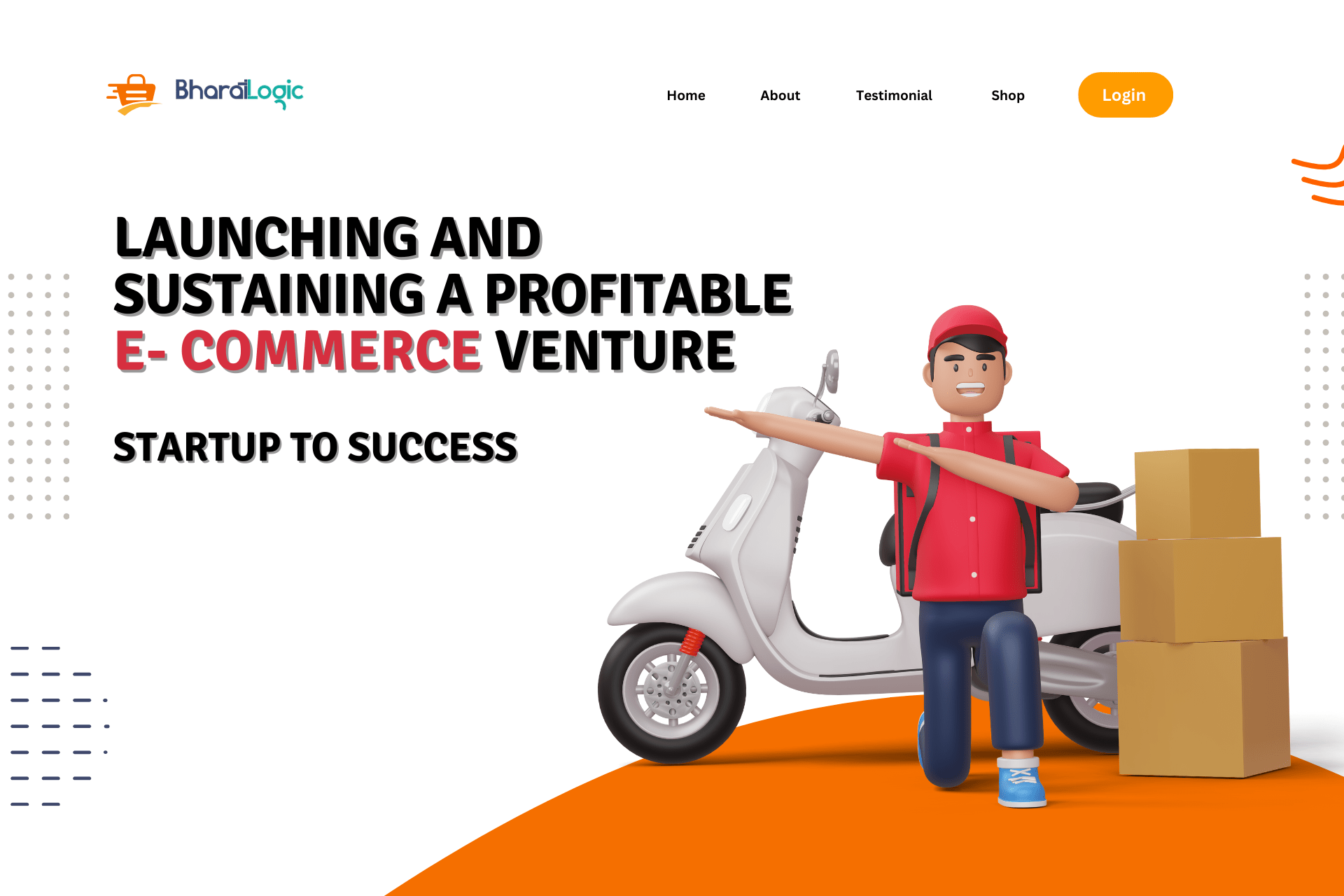The Ultimate Guide to Building a Profitable Ecommerce Business
Introduction to E-commerce
E-commerce has revolutionized the way businesses operate, providing opportunities for entrepreneurs to reach global markets from the comfort of their homes.
It’s changed how businesses work, letting them reach customers all around the world without needing a physical store. This means anyone with an internet connection can start their own online store and sell stuff. It’s made shopping super easy too – you can find and buy things anytime, anywhere, just by using a computer or phone.
E-commerce has basically made buying and selling stuff simpler and more accessible for everyone.
Types of E-commerce Models

- Business-to-Consumer (B2C):
Example: Amazon, Walmart
- Business-to-Business (B2B):
Example: Alibaba, ThomasNet
- Consumer-to-Consumer (C2C):
Example: eBay, Craigslist
- Consumer-to-Business (C2B):
Example: Upwork, Fiverr
Planning Your E-commerce Venture
Identifying Market Trends:
Assessing Competition:
Study your competitors to understand their products, prices, and marketing. This reveals how crowded the market is and where there might be gaps you can fill with your offerings.
Choosing the Right Niche:
2. Crafting a Solid Business Plan
Executive Summary:
Market Analysis:
Marketing and Sales Strategy:
Financial Projections:
Building Your E-commerce Platform

Building your e-commerce platform involves creating a digital storefront that showcases your products or services to potential customers. It’s like constructing a virtual store where visitors can browse, shop, and make purchases online. This process typically includes designing an intuitive user interface, implementing secure payment gateways, and integrating inventory management systems.
Whether you’re building a custom platform from scratch or using e-commerce platforms like Shopify or WordPress with WooCommerce, prioritizing user experience and functionality is essential for success in the competitive online marketplace.
Choosing the Right Platform
Self-Hosted vs. Hosted Solutions:
Self-hosted (like WooCommerce) offer control but need technical upkeep. Hosts (like Shopify) are easier but may have customization limits.
Customization and Scalability:
Self-hosted platforms allow extensive customization and often offer better scalability for growth.
User Experience (UX) Design:
Prioritize easy navigation, mobile-friendliness, and fast loading times for better user experience.
Security Measures:
Ensure SSL certificates, secure payment gateways, and regular updates for website security.
Product Sourcing and Inventory Management
Sourcing Options:
Consider dropshipping, wholesale purchasing, or manufacturing based on your business model and needs.
Inventory Management Systems:
Use inventory management software to monitor stock levels, manage orders efficiently, and prevent inventory shortages.
Fulfillment Strategy:
Decide between self-fulfillment, third-party logistics (3PL), or Fulfillment by Amazon (FBA) depending on your business requirements and resources.
Supplier Relationships:
Build strong relationships with dependable suppliers to ensure consistent product quality and timely deliveries, fostering trust and reliability in your supply chain.
Marketing and Promoting Your E-commerce Venture

Utilize various digital marketing channels such as social media, email campaigns, search engine optimization (SEO), and pay-per-click advertising to increase visibility and reach your target audience.
Engage with your audience through compelling content, promotions, and personalized messaging to build brand awareness and loyalty. Leverage influencer partnerships, affiliate marketing, and collaborations to expand your reach and tap into new markets. Regularly analyze metrics and data to measure the effectiveness of your marketing efforts and make informed adjustments to optimize performance and maximize return on investment.
By implementing a strategic and multifaceted marketing approach, you can effectively grow your e-commerce business and achieve sustainable success in the competitive online landscape.
Creating a Strong Brand Identity
Brand Storytelling:
Create a captivating narrative that connects with your audience’s emotions and values, drawing them into your brand’s story.
Visual Branding:
Develop distinctive visual elements like logos, colors, and imagery that represent your brand’s identity and leave a lasting impression on customers.
Building Brand Trust:
Foster trust with customers by encouraging reviews, sharing testimonials, and maintaining transparent policies, demonstrating reliability and credibility in your brand.
Managing Operations and Customer Service
Streamline your operational processes to ensure efficient order fulfillment, inventory management, and shipping logistics. Implement customer service protocols to promptly address inquiries, resolve issues, and provide exceptional support throughout the buying journey.
Utilize technology such as chatbots and automated systems to enhance customer interactions and improve response times. Continuously monitor and optimize your operations and customer service strategies to adapt to changing demands and deliver a seamless experience that fosters loyalty and satisfaction among your customers.
Streamlining Order Fulfillment
Efficient Order Processing:
Set up automated workflows for order processing to minimize errors in order fulfillment and ensure that orders are processed quickly and accurately.
Shipping and Logistics:
Enhance the customer experience by offering multiple shipping options, providing shipment tracking information, and maintaining transparent shipping policies, which can help manage customer expectations and reduce inquiries about order status.
Returns and Refunds:
Simplify the returns process with a hassle-free policy and promptly handle refunds to show customers that their satisfaction is a priority. A smooth returns experience can increase trust in your brand and encourage repeat purchases.
Customer Feedback Loop:
Establish a system for collecting feedback from customers through surveys, reviews, or other channels. Analyzing this feedback helps identify areas where improvements can be made to enhance the overall customer experience and strengthen customer satisfaction and loyalty.
Scaling Your E-commerce Business

Scaling your e-commerce business involves strategically expanding your operations to accommodate growth and meet increasing demand. This can include optimizing your website for scalability, upgrading your infrastructure to handle higher traffic volumes, and expanding your product offerings or market reach. Implementing efficient processes and leveraging technology can help streamline operations and support scalability.
Additionally, investing in marketing and customer acquisition strategies can help attract new customers and drive revenue growth. Continuously monitoring key performance metrics and adapting your strategies accordingly is essential for sustainable scaling and long-term success in the dynamic e-commerce landscape.
Analyzing Performance Metrics
Product Development:
Actively engage with customer feedback and market trends to refine existing products or introduce new ones. This iterative process ensures that your offerings remain relevant and appealing to your target audience.
Partnerships and Collaborations:
Seek out strategic partnerships with brands or influencers whose audience aligns with yours. By joining forces, you can tap into new markets, gain exposure to a broader audience, and benefit from shared resources and expertise.
Key Performance Indicators (KPIs):
Key performance indicators provide valuable insights into the health and effectiveness of your business operations. By monitoring metrics like conversion rate (percentage of website visitors who make a purchase), average order value (average amount spent per order), and customer acquisition cost (cost to acquire a new customer), you can assess your performance and make informed decisions to optimize your strategies.
Google Analytics Insights:
Google Analytics is a powerful tool that provides in-depth data on how users interact with your website. Analyzing metrics such as bounce rate, session duration, and goal completions allows you to gain valuable insights into user behavior, identify areas for improvement, and optimize your website for better performance and conversions.
Sales Funnel Optimization:
The sales funnel represents the journey that customers take from initial awareness to making a purchase. By analyzing each stage of the funnel, you can identify where customers are dropping off and implement strategies to address any bottlenecks, improve conversion rates, and ultimately increase sales.
Competitor Benchmarking:
Benchmarking your performance against competitors provides valuable context and insights into your market position. By analyzing competitors’ strategies, strengths, and weaknesses, you can identify opportunities for differentiation, innovation, and improvement within your own business. This helps you stay competitive and adapt to changes in the market landscape.
Staying Ahead of the Curve: Trends and Innovations
Embracing Emerging Technologies
Artificial Intelligence (AI) and Machine Learning:
Voice Commerce:
The amount of capital required depends on various factors such as business model, niche, scalability, and marketing strategy. While some e-commerce ventures can be bootstrapped with a minimal budget, others may require significant investment in inventory, marketing, and technology infrastructure.
Some common pitfalls include inadequate market research, poor platform selection, lack of differentiation, inefficient inventory management, and subpar customer service. It’s essential to conduct thorough planning and address potential challenges proactively.
Differentiation can be achieved through unique product offerings, exceptional customer service, compelling branding, personalized shopping experiences, and innovative marketing campaigns. Focus on building a strong brand identity and providing value-added services to set yourself apart from competitors.
Mobile optimization is critical for e-commerce success, as an increasing number of consumers prefer to shop on mobile devices. Ensure that your website is responsive, loads quickly on mobile devices, and provides a seamless shopping experience across all screen sizes.
Emerging trends include omnichannel retailing, social commerce, sustainability initiatives, subscription-based models, and experiential shopping experiences. Keeping abreast of these trends and adopting relevant technologies can give your e-commerce business a competitive edge in the market.

